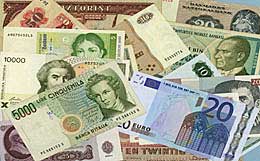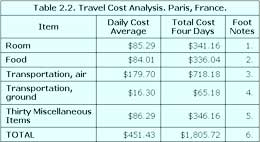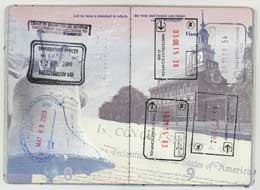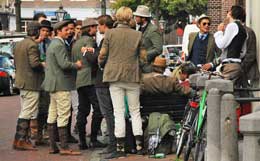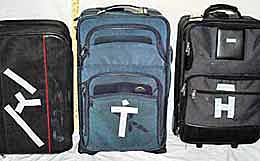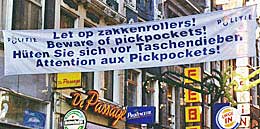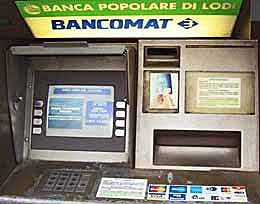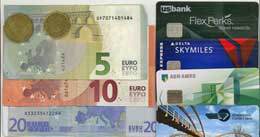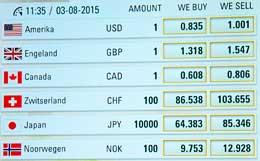European Dates and Time Zones
Traveling in a Distant World
International system, calendars, time zones, daylight saving time, 24 hour time, telling time.
European calendars have a habit of throwing you off by a day. That is because the European week starts on Monday, not Sunday. But all weeks are numbered on office calendars such as this Dutch model so Monday ends up in the second column after all.
Note the multitude of languages. The top row for the previous month has Nederlands in first place and English second. On blue days the offices are closed. Holidays are indicated by small ovals which include the two or three letter international abbreviation for the countries which have a celebration. Just about everybody gets New Year's Day to recover and rewind. Seven countries take liberty on January 6 to celebrate the Epiphany.
Learn more about holidays at Prime Travel Data: Elementary Travel Information for Europe.
Carpe diem. Vivere bene! Gratia Deo.
HOW TO EUROPE: The Complete Travelers Handbook - - Chapter 28 - -
This entire book is published gratis on-line by the author, photographer, and webmaster, John Bermont, a DIY job with help from my daughter Stephanie. I welcome all questions, comments, and complaints.
For contact information please see Your Blow Back. Last update .
On the clock, Europe will always be ahead of the USA.
DATES -- INTERNATIONAL SYSTEM
Flipped
There is a major difference in the way dates are written. Europeans use the day/month/year arrangement rather than the month/day/year system used in America. Thus, to you 6/2/13 is June 2, 2013. To the hotel keeper in France that is February 6, 2013. You didn't intend to spend February in Paris, and he certainly won't hold your room until June.
Because of the international nature of the Internet many sites which require you to enter a date specify one arrangement or the other. You are likely to see dd/mm/yyyy for globally oriented sites or mm/dd/yyyy for home town sites in the USA.
If you are dealing in data you are likely to see yyyymmdd as the visible script on screen. This makes it handy to file information. If you look at the source code you are more likely to see a number like 41953 with a format code indicating the appearance of the date on screen. This number is the number of days since January 1, 1900, a base for many computer programs.
Dashes and Slashes
The date is commonly written with points, as 6.2.14, rather than the dashes or slashes common in the USA. To avoid mix-ups, get into the habit of writing dates with the month abbreviated rather than numbered, i.e., 6 Feb 14. Due to the common Roman origin of calendar month names, the three letter abbreviations are almost universally recognized. A system that is coming into general use in timetables is to use a Roman numeral for the month. Thus, February 6, 2014 would be 6 II 14 and June 2, 2014 would be 2 VI 14.
Your Documents
You can do little about your driver's license or birth certificate if it is dated in the American system. Just be prepared for official headaches if you need to show these in the small towns. A little number that looks wrong to a bureaucrat or police officer can be a mighty big headache.
Calendars
Last but not least, here is one more thing that is different between the USA and Europe. American calendars start with Sunday and run across the page to Saturday. In Europe, most calendars start with Monday and run across to Sunday. I sent an American wall calendar to my friend Paula in Holland. She made a note of a party just by the position of the day on the calendar, out of habit. When she prepared to go she followed the column positions. She sure surprised the host being a day early!
Even worse, some European calendars run the days of the week down the side rather than across the top. These also start with Monday. Very very confusing. It is easier to read rune stones.
TIME
There are two baselines regarding time on Mother Earth. The International Dateline runs north-south through the middle of the Pacific Ocean. This line determines the turning of one day to the next.
The other line, the Prime Meridian, runs north-south exactly on the other side of the world through the English city of Greenwich, a suburb of London. Britain ruled the waves and continents at one time so they got first dibs on this. The time at Greenwich is Greenwich Mean Time, a.k.a. GMT. It is also called Coordinated Universal Time, or UTC for short. Why don't they call it CUT? It's a French thing.
Time at places east of Greenwich can be expressed with a plus sign in front of the GMT, e.g. Moscow is GMT+3 hours. At noon in London it is 3 PM in Moscow. GMT with a negative sign indicates time west of Greenwich. Example, New York is GMT-5 hours. During Daylight Saving Time (what a stooopud concept that is) New York is GMT-4 hours.
Knowing this is not especially important, but it won't hurt you either. On the other hand, I recall the time I phoned a major airline to buy a specially discounted ticket to Germany. The special offer was due to expire at midnight Friday so I called on Friday evening from Los Angeles to book my ticket. The special offer had already expired. That airline used GMT as its clock and it was already early Saturday morning GMT over there. With some prodding on my part the agent gave me the special fare anyway. Darn near everything is negotiable.
Time Zones
Because Europe is about a third of the way around the world toward the east, the sun rises there before it does in America and the time in Europe is always about a third of a day ahead of ours. To find the time in countries of Western Europe from these United States, use the following tables.
|
Table 1. The four European Time zones |
|
|---|---|
|
Western
WET* |
Iceland, Ireland, Portugal, United Kingdom |
|
Central
CET |
Albania, Andorra, Austria, Belgium, Bosnia, Croatia, Czech Republic, Denmark, France, Germany, Hungary, Italy, Liechtenstein, Luxembourg, Macedonia, Netherlands, Norway, Poland, Serbia, Slovakia, Slovenia, Spain, Sweden, Switzerland, and Vatican City. |
|
Eastern
EET |
Belarus, Bulgaria, Estonia, Finland, Greece, Latvia, Lithuania, Moldova, Romania, Turkey, Ukraine |
|
Moscow
MSK |
Western Russia |
| * WET is Western European Time, and so forth. | |
|
Table 2. Time calculation table. |
||||||
|---|---|---|---|---|---|---|
| To find the time in the European Time Zone below: | add the number of hours corresponding to your USA Time Zone | |||||
|
EST
GMT +5 |
CST
GMT +6 |
MST
GMT +7 |
PST
GMT +8 |
AKST
GMT +9 |
HST
GMT +10 |
|
|
WET
GMT |
5 | 6 | 7 | 8 | 9 | 10 |
|
CET
GMT-1 |
6 | 7 | 8 | 9 | 10 | 11 |
|
EET
GMT-2 |
7 | 8 | 9 | 10 | 11 | 12 |
|
MSK
GMT-3 |
8 | 9 | 10 | 11 | 12 | 13 |
| See the notes below on Daylight Saving Time. | ||||||
Example Calculations
Problem:What time is it in Paris, France when it is noon in Chicago?
Solution: Table 1 shows that France is in the Central European Time zone (CET). If you live in Chicago you know that it is in the USA Central Time zone (CST). Find the intersection of the row and column in Table 2. This shows that there is a 7 hour time difference between Chicago and Paris. Then add seven hours to noon, 12:00, in Chicago and you get 19:00 on the 24 hour clock in Paris. Deduct 12 and the answer is 7:00 PM in Paris.
Problem:What time is it in Los Angeles when it is 8:00 PM in Istanbul, Turkey?
Solution:Los Angeles is on USA Pacific Standard Time (PST) and Istanbul is on European Eastern Time (EET). Table 2 shows that the time difference is 10 hours. Convert the Istanbul time to the 24 hour clock by adding 12 hours. This is then 20:00, which I like to write as 20h00. Subtract 10 hours from 20h00 and you have 10 hours. This is the same on the 24 hour clock and the 12 hour clock. So, at 8:00 PM in Istanbul it is 10:00 AM in Los Angeles.
Daylight Saving Time and Summer Time
Daylight Saving Time is practiced in most countries of Europe. It is called Summer Time. Some countries have adopted it only recently, and some haven't tried it yet.
The period for Daylight Saving Time in the USA is from 02h00 local time on the second Sunday of March to 02h00 on the the first Sunday of November. However this is a state issue. Common sense prevails in Arizona, Hawaii, and Puerto Rico where DST is not observed.
The period for Summer Time in most European countries is different, of course. It starts at 01h00 GMT on the last Sunday in March and ends at 01h00 GMT on the last Sunday in October.
So there are two weeks in the middle of March and a week at the end of October when the Time Calculation Table above is not accurate. Also, Russia has a slightly different way of doing things. No surprise there.
Daylight Saving Time and Summer Time have been around for decades but are still controversial. Countries change the start/stop dates now and then (USA 2007) just for amusement and some countries opt out.
It is always a good idea to check the local time when crossing borders. I once missed my breakfast in Italy because I had not reset my watch after crossing the night before from Switzerland, before Switzerland adopted Summer Time. But not all local clocks are on time. Clocks in train stations in Portugal and Italy can be out of synchronization by several minutes or more. Que sera sera.
GMT does not go on Daylight Saving Time.
24 Hour Time
Time is officially kept on the 24 hour basis on train schedules, on NO PARKING signs, and on other items of importance. But most clocks are 12 hour clocks.
If a time of 1300 or greater is stated on a schedule, subtract 12 and add PM. Get used to the concept of 14h00 being 2:00 in the afternoon, and 2100 being 9:00 in the evening. Even some Europeans get confused and can slip into thinking that 14:00 is 4:00 PM. Your train left at 2:00 PM. Stephanie's aunt was to have picked her up at the Milan station at 14:50. Somehow Anita figured that was 12:50 and went to the station two hours early — no Stephanie in sight, followed by trans-Atlantic phone calls and more confusion. Stephanie parked herself near the front door of the station until the adults got their stuff assembled and Anita picked her up. I use my trusty alarm chronograph when traveling in Europe with the time indication set on 24 hour notation.
If it is a whole number of hours, the time may be written simply as 15h. If it is 3:30 PM, it may be written as 15.30 or as 15h30.
Note: I've deliberately mixed up and written these 24 hour times in different ways. There is no uniformity in Europe either. This is more training to prepare you for the various ways of doing things in Europe's four dozen countries. You can deal with it.
Telling Time
Time is expressed in different ways. For instance, 2:30 in America is "half past two." In Britain it is "half two." In Holland it is "half three." And in Holland, tien voor half drie (ten before half three) is 2:20. Be careful that you don't miss an appointment because of these little quirks of custom.
Have a good trip!
HOW TO EUROPE
The Complete Travelers Handbook
Table of Contents
Chapter 1
What's It All About?Travel Like a Native In Europe
Chapter 2, Part 1
On Budget in EuropeTravel Costs: How Much?
Chapter 2, Part 2
Europe on WHAT! Per Day?My Actual Expenses
Chapter 3
Passport and VisasIdentity and Travel Documents for Europe
Chapter 4
Flying to EuropeTravel Starts at the Airport
Chapter 5
What to Wear in EuropeYour Best Travel Clothes
for All Occasions
Chapter 6 Part 1
Pack Light Field TestTravel Europe in Comfort and Style
Chapter 6 Part 2
Personal Care ItemsPack Your Toothbrush, Hair Blower, Toilet Paper, and Vinegar.
Chapter 6 Part 3
Travel SuppliesSmall Stuff Packing List
Chapter 6 Part 4
Bringing Valuables to EuropeNot in Your Luggage or Purse
Chapter 7
Luggage for EuropePack Light, Let It Roll
Chapter 8 Part 1
Pickpockets in EuropeThey're Everywhere
Chapter 8 Part 2
ATMs in EuropeMachines Dispense Travel Cash
Chapter 8 Part 3
Cash and CreditPaying Your Way in Europe
Chapter 8 Part 4
Money PotpourriCash, Coins, Transfer, Barter
For the other 22 chapters and much more see
HOW TO EUROPE
The Complete Travelers Handbook






